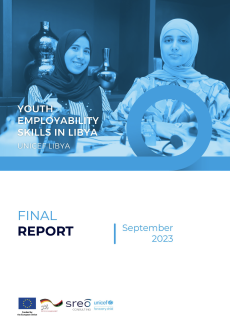A study published last Thursday, conducted by UNICEF Libya, entitled “Youth Employability Skills Study” provides a comprehensive overview of Libyan labour market trends on the employability of youth aged 15-24.
The study identifies and maps gaps in the employability skills of youth, evaluates existing government policies and legislation supporting youth employability, and identifies barriers to employability that youth face. It considers the differences between genders, formal and informal sectors, and different regions in Libya.
UNICEF says the findings of this study provide a better understanding of the challenges and opportunities surrounding youth employability, and the study’s actionable recommendations serve as a valuable tool to plan future interventions to support youth in Libya.
Here are some of the study’s key findings:
- There are around 1.1 million Libyans between the ages of 15 and 24, with a youth unemployment rate of 51.4%, one of the highest of any country in the world. This is attributed to a weak private sector, limited economic diversification, and a competitive job market dominated by the public and informal sectors.
- 24% of respondents reported that they were working (including those with part-time and informal roles), while 72.5% were out of work, and 3.5% declined to answer this question.
- Youth in Libya face numerous barriers to employment, notably a lack of open positions (45%), limited social connections (32%), inadequate skills (28%), a lack of information about available jobs, and the influence of nepotism in recruitment processes. Women, youth with disabilities, ethnic minorities and those from rural areas face additional specific barriers to accessing employment and training.
- Over 85% of respondents noted that lack of funding is the key barrier to start up a business and over 12% mentioned bureaucratic impediments/permits.
- In terms of essential skills reading (41%) and writing (29%) were the ones identified as most in need of improvement.
- Of the advanced skills, the most in need to find a job are English proficiency (50%); interpersonal skills (41%); coding (30%) and knowledge of business/finance and IT (24% each).
The study made recommendations to improve youth employability which it grouped around 4 thematic pillars, each with their own set of specific recommendations:
- Improvement to education, training and development programmes available for Libyan youth, including development and rollout of life skills training, and strengthening of the TVET sector;
- Investment in infrastructure for new and existing training facilities, and support for the construction sector in Libya, a potential employment growth area;
- Strengthened advocacy around youth employability, changing attitudes to women and marginalized groups in the workplace, and improving the Libyan perceptions of the private sector;
- Strengthened partnerships and linkages between the youth population, training facilities, and the private sector labour market, and support for entrepreneurship among youth in Libya.
Libya’s unemployment stats are inaccurate says Labour Minister (libyaherald.com)
Libya’s unemployed 390,000 or 15 percent of workforce: Ministry of Labour | (libyaherald.com)
Labour Ministry to launch new website to ease job searches | (libyaherald.com)
Libya has 2.3 million state-sector workers: Labour Ministry | (libyaherald.com)
118,000 Libyans officially looking for work: Ministry of Labour | (libyaherald.com)
Unemployment at 15%: government official | (libyaherald.com)










